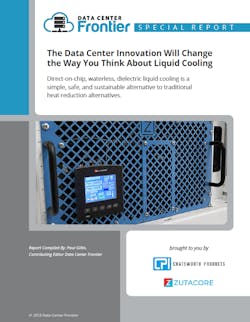It's Time to Change the Way You Think About Liquid Cooling
This launches our article series on the latest innovations in liquid cooling technology.
The growing demand for high-density servers to support high-performance computing, artificial intelligence, and data analytics workloads at a massive scale is challenging conventional approaches to data center cooling.
Despite major gains in power efficiency, microprocessors are becoming steadily more power- hungry and giving off more heat as a result. The latest generation of microprocessors runs at more than 400 watts, up about 60% from five years ago. Roadmaps published by makers of server processors indicate that 600 watts could be the norm by the mid-2020s.
At the same time, rack density is also growing. The average server density per rack more than tripled between 2011 and 2020, according to Uptime Institute. Some racks now draw as much as 16 kilowatts and the high-performance computing infrastructure required to support artificial intelligence workloads may soon demand up to 50 kilowatts. And the trend is up and to the right. By some accounts, the AI hardware market will grow tenfold over the next five years.
The heat generated by all this computing power is too great for conventional cooling systems to tame. Data center operators have relied on room-scale air-conditioning for decades, but that approach has numerous disadvantages from an economic, environmental, and efficiency perspective.
Join us on Aug. 29th for a day of learning covering air-based cooling and direct-on-chip cooling technologies, and optimizing the data center cooling cycle. Register for the Data Center Frontier Cooling Educational Forum today.
Although the technology has improved and many data center operators have adopted efficient best practices such as the use of blanking panels, air dams, and airflow containment to raise room air temperatures to the limits specified by the American Society of Heating, Refrigerating, and Air-Conditioning Engineers to maximize existing infrastructure, there are limits to how much air-cooling methods can achieve.
For one thing, air-conditioning is inherently wasteful because it cools the entire room rather than just the equipment inside. It requires managed airflows and mandates careful attention to space design to avoid airflow blockages that can cause disruptions that ultimately lead to overheating and equipment failure.
For the growing number of organizations that are focused on environmental, social, and governance issues, air-conditioning is also a liability because of its high energy cost and use of climate-threatening chemicals. At a time when water is increasingly becoming a precious commodity in many areas of the country, thermoelectric power plants are the largest source of water withdrawals in the U.S., consuming nearly 12,000 gallons per megawatt hour generated in 2020.
As Time magazine summed it up two years ago, AC Feels Great, But It’s Terrible for the Planet.
Download the full report, The Data Center Innovation Will Change the Way You Think About Liquid Cooling, featuring Chatsworth Products and Zutacore, to learn more. In our next article, we'll explore the advantages of liquid cooling.



